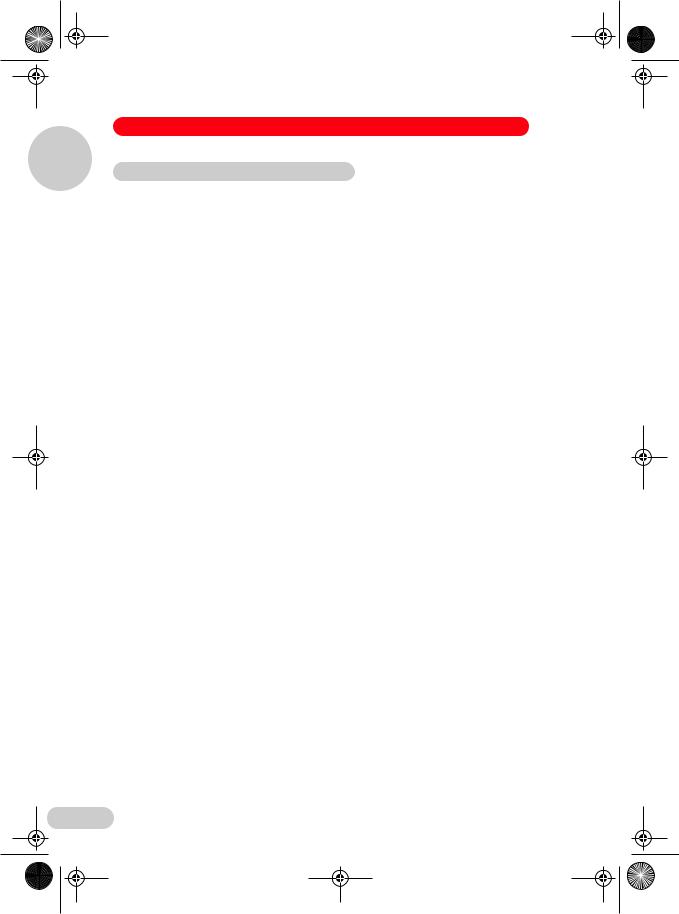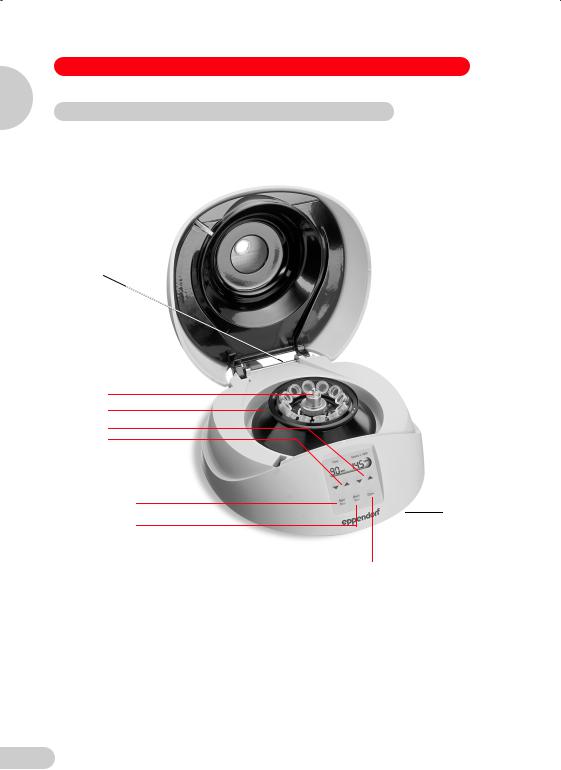Eppendorf MiniSpin plus User Manual

MiniSpin® / MiniSpin® plus

Titel_Klapps.fm Seite 2 Montag, 3. November 2008 10:55 10
Contents
Contents
MiniSpin / MiniSpin plus
Instruction Manual. . . . . . . . . . . . . . . . . . . . . . . . . . . . . . . . . . . . . . . . . . . . . . . . . . . . . 17
Istruzioni brevi . . . . . . . . . . . . . . . . . . . . . . . . . . . . . . . . . . . . . . . . . . . . . . . . . . . . . . . . 34
Aiutaci a valutare i nostri manuali di istruzione su www.eppendorf.com/manualfeedback!
2

Mikrocentrifuge MiniSpin / MiniSpin plus
Abb. 1 / Fig. 1
Abbildung 1 / Figur 1
1
2
3
4
5
START/STOP
E
SHORT-SPIN
|
|
|
OPEN |
1 |
Netzschalter und -stecker |
1 |
Mains switch and plug |
2 |
Rotormutter |
2 |
Rotor nut |
3 |
Rotor |
3 |
Rotor |
4 |
▼▲ RPM/RZB |
4 |
▼▲ rpm/rcf |
5 |
▼▲ Zeit |
5 |
▼▲ Time |
3

No part of this publication may be reproduced without the prior permission of the copyright owner.
Copyright© 2005 Eppendorf AG, Hamburg
4

Contents
1 |
Introduction . . . . . . . . . . . . . . . . . . . . . . . . . . . . . . . . . . . . . . . . . . . . . . . . . . . . . . . . |
18 |
1.1 |
Intended use . . . . . . . . . . . . . . . . . . . . . . . . . . . . . . . . . . . . . . . . . . . . . . . . . . . . . . . . . |
18 |
1.2 |
Delivery package . . . . . . . . . . . . . . . . . . . . . . . . . . . . . . . . . . . . . . . . . . . . . . . . . . . . . |
19 |
1.3 |
Installing the device . . . . . . . . . . . . . . . . . . . . . . . . . . . . . . . . . . . . . . . . . . . . . . . . . . . |
19 |
2 |
Safety precautions and applicational limitations. . . . . . . . . . . . . . . . . . . . . . . . . . . |
20 |
3 |
Operation. . . . . . . . . . . . . . . . . . . . . . . . . . . . . . . . . . . . . . . . . . . . . . . . . . . . . . . . . . . |
22 |
3.1 |
Control elements. . . . . . . . . . . . . . . . . . . . . . . . . . . . . . . . . . . . . . . . . . . . . . . . . . . . . . |
22 |
3.2 |
Rotor insertion and removal . . . . . . . . . . . . . . . . . . . . . . . . . . . . . . . . . . . . . . . . . . . . . |
22 |
3.3 |
Loading the rotor . . . . . . . . . . . . . . . . . . . . . . . . . . . . . . . . . . . . . . . . . . . . . . . . . . . . . |
22 |
3.4 |
Centrifugation with a preset time . . . . . . . . . . . . . . . . . . . . . . . . . . . . . . . . . . . . . . . . . |
23 |
3.5 |
Short-spin centrifugation . . . . . . . . . . . . . . . . . . . . . . . . . . . . . . . . . . . . . . . . . . . . . . . |
23 |
3.6 |
Continuous centrifugation (for MiniSpin plus only). . . . . . . . . . . . . . . . . . . . . . . . . . . . |
23 |
3.7 |
Switching to the rcf display (for MiniSpin plus only). . . . . . . . . . . . . . . . . . . . . . . . . . . |
24 |
3.8 |
Opening the centrifuge in the event of a power failure. . . . . . . . . . . . . . . . . . . . . . . . . |
24 |
4 |
Maintenance and cleaning. . . . . . . . . . . . . . . . . . . . . . . . . . . . . . . . . . . . . . . . . . . . . |
25 |
5 |
Troubleshooting . . . . . . . . . . . . . . . . . . . . . . . . . . . . . . . . . . . . . . . . . . . . . . . . . . . . . |
26 |
6 |
Technical data . . . . . . . . . . . . . . . . . . . . . . . . . . . . . . . . . . . . . . . . . . . . . . . . . . . . . . . |
27 |
7 |
Ordering information . . . . . . . . . . . . . . . . . . . . . . . . . . . . . . . . . . . . . . . . . . . . . . . . . |
28 |
Contents
17

1
Introduction
1 Introduction
MiniSpin and MiniSpin plus are compact, easy-to-operate tabletop centrifuges, which are ideal for use as "personal centrifuges".
Twelve Eppendorf micro test tubes can be centrifuged simultaneously in a 45° fixed-angle rotor F-45-12-11 using the following performance data:
|
Relative centrifugal force |
Rotational speed |
Max. centrifuging |
|
rcf |
rpm |
radius (cm) |
|
|
|
|
MiniSpin® |
12,100 |
13,400 |
6 |
MiniSpin® plus |
14,000 |
14,500 |
6 |
The rotor F-55-16-5-PCR is a fixed-angle rotor for centrifuging 16 PCR tubes (0.2 ml) or two 5 or 8-strips 0.2 ml PCR tubes with the following performance data:
|
Relative centrifugal force |
Rotational speed |
Max. centrifuging |
|
rcf |
rpm |
radius (cm) |
|
|
|
|
MiniSpin® |
9,840 |
13,400 |
4.9 |
MiniSpin® plus |
11,520 |
14,500 |
4.9 |
Before starting up MiniSpin or MiniSpin plus for the first time, please read the rest of this operating manual. The latest version of the manual and the safety instructions in your language can be found on the Internet at www.eppendorf.com.
This sign is found on your centrifuge and on several pages in the operating manual. Texts labeled with this sign contain safety notes. Read these safety precautions before using the centrifuge for the first time.
1.1 Intended use
The MiniSpin / MiniSpin plus is intended exclusively for indoor use and for separating aqueous solutions and suspensions of various densities in approved test tubes.
This device may only be operated by trained specialist staff.
18

1Introduction
1.2Delivery package
1 MiniSpin or MiniSpin plus
1 Rotor F-45-12-11
1 Stainless steel rotor lid
1 Rotor nut
1 Mains cable
1 Operating manual
1.3 Installing the device
Place the centrifuge onto a level, horizontal surface. Make sure that
the ventilation slits are not blocked! In accordance with the safety regulations of
IEC 1010-2-020 (equivalent to EN 61010-2-020), a safety distance of 30 cm should be observed around the centrifuge during operation. No objects which could cause additional damage in the event of a centrifuge crash should be positioned in this space.
Before plugging in the centrifuge, compare your power supply with the electrical requirements listed on the identification plate on the underside of the device.
The mains switch is located at the rear of the device. The centrifuge is ready to operate when the display becomes visible. Place the rotor onto the rotor axle and tighten using the rotor nut.
Before starting up the centrifuge for the first time, make sure that the rotor nut is securely fastened.
1
Introduction
19

2
Safety precautions and applicational limitations
2 Safety precautions and applicational limitations
The rotor and the rotor lid must always be securely fastened.
If the centrifuge makes unusual noises when started, the rotor or rotor lid is not fastened correctly. Switch the device off immediately by pressing "STOP".
The stainless steel rotor lid may only be used in the MiniSpin® / MiniSpin® plus and MiniSpin® SPACE centrifuges for the recommended application areas.
The rotors must only be loaded symmetrically.
Do not use centrifuges that have not been correctly installed or repaired.
Repairs must only be performed by an Eppendorf authorized service technician. Only use original rotors and spare parts recommended by Eppendorf.
MiniSpin / MiniSpin plus may be used for the specified applications only. They must not be operated in a hazardous or flammable environment and must not be used to centrifuge explosive or highly reactive substances.
When handling toxic or radioactive liquids or pathogenic bacteria from Risk Group II (see World Health Organisation: "Laboratory Biosafety Manual"), observe the safety regulations of the country in question.
If such liquids are spilled in the rotor or rotor chamber, the centrifuge must be cleaned carefully and properly.
Before using cleaning or decontamination methods other than those stipulated by the manufacturer, contact the manufacturer to ensure that the intended method will not damage the centrifuge.
Prior to centrifugation, the tubes should in any case be visually inspected for material damage. Damaged tubes may not be centrifuged. This is because broken tubes can, in addition to sample loss, result in further damage to the centrifuge and accessories.
Close the test tube lids before centrifuging. Open lids can be ripped off during centrifuging and damage the centrifuge.
A liquid density of 1.2 g/ml must not be exceeded at the maximum rotational speed.
When moving the centrifuge from a cold room to a normal lab, run the centrifuge for 30 minutes beforehand in the cold room so that it does not get covered in condensation. Alternatively, allow it to warm up in a lab for at least three hours, but do not plug in the centrifuge in order to prevent damage caused by condensation.
Rotors and rotor lids are high-grade components which are subject to extreme mechanical strain. Even slight scratches and tears can lead to serious internal material damage. Avoid damage caused by aggressive chemicals, including among others: Strong and weak alkali, strong acids, solutions with mercury, copper and other heavy metals, chlorinated hydrocarbons, concentrated saline solutions and phenol.
In the event of contamination caused by aggressive agents, the rotor must be cleaned immediately using a neutral cleaning liquid. This is particularly important for the bores for the tubes.
20
